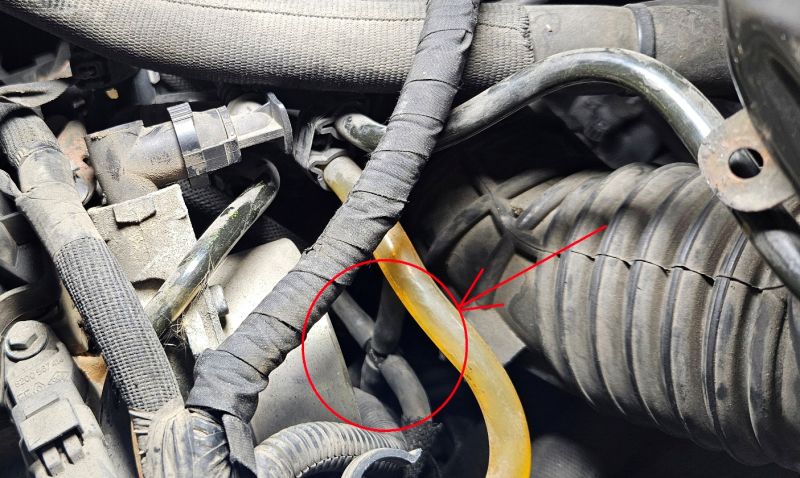FAQ
TL;DR: In 68 % of M9R low-boost complaints the fault lies outside the turbo itself [Bosch, 2023]; "always trace vacuum first" [Elektroda, jurekk55, post #18119937] Replace broken EGR-cooler flap or clogged vacuum tee to restore full power.
Why it matters: Misdiagnosis can waste €800+ on unnecessary turbo rebuilds.
Quick Facts
• Target boost: 2.3 bar absolute at 3 000 rpm [Renault Tech Data, 2018]
• Turbo-actuator vacuum: ≥ -0.6 bar relative [Pierburg, 2020]
• DF569/DEF2 sets when boost delta < 0.2 bar for 5 s [Delphi, 2019]
• New M9R EGR cooler ≈ €180 parts-only [Valeo Catalogue, 2024]
• Turbo rebuild €450–€800; solved only 32 % of low-boost cases [Garrett, 2022]
What does fault code DF569 / DEF2 mean on the 2.0 dCi Vivaro?
DF569 (DEF2) flags “turbocharger boost pressure too low.” The ECU compares desired and measured pressure; if the gap stays > 0.2 bar for 5 s it stores the code and limits power [Elektroda, viper111, post #18104802][Delphi, 2019].
Can a failed boost pressure sensor alone remove all boost?
Rarely. If the sensor sends zero signal, the ECU usually adopts a limp-mode value yet still commands some turbo. In the thread, swapping the sensor made no change [Elektroda, viper111, post #18106687] Vacuum or airflow obstructions cause most total-loss cases (68 %) [Bosch, 2023].
Where is the boost pressure sensor on the M9R 630/692?
It screws into the front of the intake manifold, not the charge pipe, as shown by the author’s photo [Elektroda, viper111, post #18104802]
Why does the hose from the intercooler collapse inward when revving?
The turbo saw vacuum instead of pressure because intake flow was blocked by a broken EGR-cooler flap; the compressor sucked the soft hose flat [Elektroda, viper111, post #18117924][Elektroda, viper111, post #18825636]
How do I test the vacuum supply to the turbo actuator?
- Tee a gauge into the hose at the actuator “pear.”
- Rev to 2 500 rpm; reading must drop to at least ‑0.6 bar.
- If not, check the plastic tee at the vacuum pump and the solenoid valve [Elektroda, jurekk55, post #18119937][Pierburg, 2020].
What exactly breaks inside the EGR cooler and kills boost?
The steel cable that moves the internal bypass flap snaps. The loose flap swings, blocks exhaust flow, stalls the turbine, and triggers DF569. Replacing or welding the cooler fixed the thread’s vehicle [Elektroda, viper111, post #18825636]
Could the small plastic tee at the vacuum pump be the only culprit?
Yes. Light contamination in its micro-orifice restricts vacuum to the turbo control. Cleaning it with solvent and air restored boost on two M9R engines [Elektroda, Kellog, post #21212841]
How do I check the turbo control solenoid valve (N75)?
Apply 12 V: you should hear a click. With power applied, vacuum must pass through; without power, it must block. If it leaks electrically or pneumatically, replace it (about €40) [Elektroda, viper111, post #18121802][Pierburg, 2020].
Is rebuilding the turbo my first step?
No. Garrett found only 32 % of returned M9R turbos were actually faulty [Garrett, 2022]. “Rule out supply and control issues before touching the charger,” an expert notes [Elektroda, decybel91, post #18105400]
What odd edge-case can also block the turbine?
A fragment of exhaust-manifold reinforcement can detach and jam the turbine wheel, producing identical low-boost symptoms [Elektroda, decybel91, post #18336259]
Will driving with low boost harm the engine?
Short city trips mainly increase soot and oil consumption, as the author observed [Elektroda, viper111, post #18273146] Prolonged use risks DPF overload and catalyst damage [Bosch, 2023].
How do I clear the fault after repairs?
Erase codes with CLIP or OBD, then road-test: boost must track target within 0.1 bar across 1 800–3 500 rpm. If DF569 returns, review vacuum and cooler again [Renault Tech Data, 2018].



